Create High-Impact Container Gardens With Grasses
http://decor-ideas.org 07/30/2015 03:13 Decor Ideas
You’ve probably heard the phrase thriller, filler and spiller as it relates to container design. The thriller is considered the main plant, the one with the wow factor; the filler makes up the heart or center of the design; and the spiller adds dramatic flair by draping over and down the sides of the container.
Grasses, or plants with grass-like foliage, have the ability to play all three roles. As with landscape design, successful container design is all about finding the right combination of color, size, form and texture, just on a smaller scale. Including grasses in your arrangement is a great way to add a strappy texture. Here’s a selection of eight gorgeous plants sure to spice up your containers.
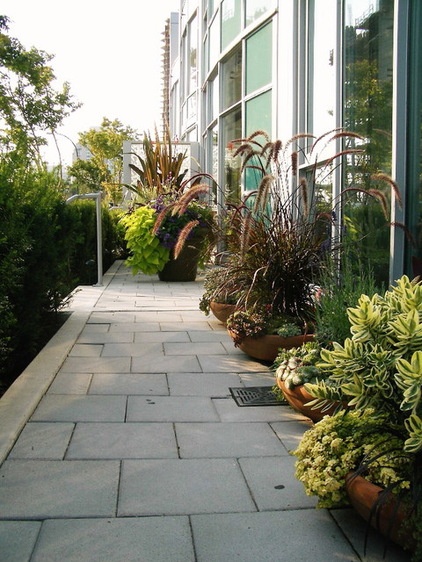
The Thrillers
There’s no denying the dramatic impact of purple fountain grass (Pennisetum setaceum ‘Rubrum’, USDA zones 7 to 11; find your zone) and its fuzzy plumes that burst above a tight tuft of dark purple foliage.
Fountain grass prefers full sun and can be considered drought-tolerant once established. Its dusty red flower heads, blooming summer through fall, will gently sway on a breezy day, maybe even tickling a passer-by with their soft tips.
Other plants shown: Sweet potato vine (Ipomea sp.) and New Zealand flax (Phormium sp.) in the rear and variegated hebe (Hebe ‘Variegata’, zones 7 to 10) in front
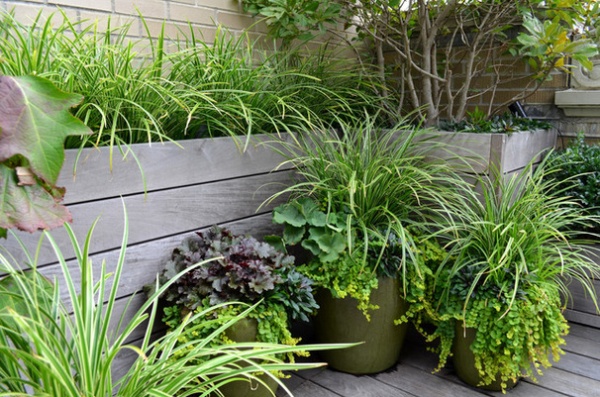
‘Ice Dance’ Japanese sedge (Carex morrowii ‘Ice Dance’, zones 5 to 9) is a more subtle but equally impressive thriller shown in this pot grouping. The sedge planted in the center of the pots is the star, as it ties into the landscape by mimicking the planting in the raised wood planter behind it.
‘Ice Dance’ is an evergreen sedge that prefers partial shade and moist soil. Its white leaf margins add a touch of brightness, making it the perfect choice for a container in a shady corner.
Other plants shown: Coral bells (Heuchera ‘Plum Pudding’, zones 4 to 9), creeping jenny (Lysimachia nummularia, zones 3 to 9)
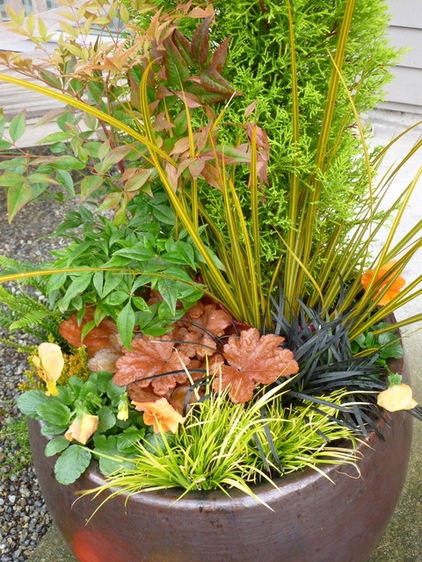
The Fillers
Goldfinger New Zealand iris (Libertia ixioides ‘Goldfinger’, zones 7 to 9) isn’t a grass at all, but its strappy orange foliage creates a similar effect. This evergreen iris grows in a tight tuft with green leaves that have a striking golden yellow stripe down the center. Here, a young plant fans out from the center of the arrangement, drawing the eye in toward the detail of the full arrangement.
It prefers full sun to partial shade and moist soil.
Other plants shown: Black mondo grass (Ophiopogon planiscapus ‘Nigrescens’, zones 5 to 10) on the right and grassy-leaved sweet flag (Acorus gramineus ‘Pusillus Minimus Aureus’) in the front center
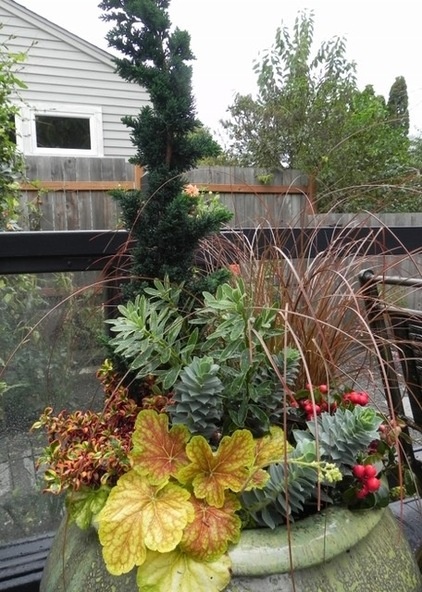
The long, delicate foliage of this Cappuccino sedge (Carex tenuiculmis ‘Cappuccino’, zones 6 to 9) arches over the plantings in the front of this container. Its thin, flat blades intermingle with, but never overpower, its companion plantings. Here, the sedge balances the design by adding a wispy texture to the composition.
This evergreen sedge prefers full sun to partial shade and moist soil.
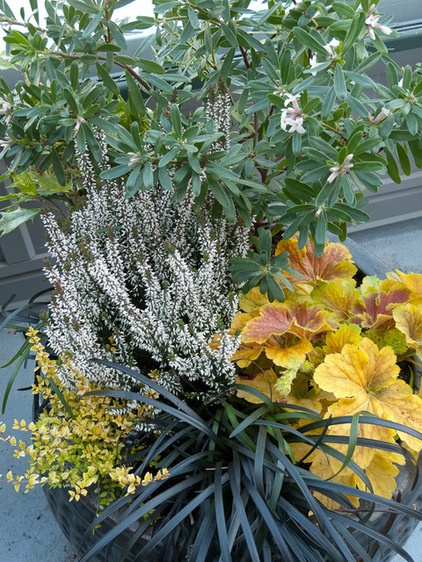
The Spillers
Black mondo grass (Ophiopogon planiscapus ‘Nigrescens’, zones 5 to 10), with its inky black strands, adds contrast to a container. The black blades pick up on the dark eye of a flower or veins of a leaf.
Black mondo grass is evergreen and prefers full sun to partial shade. It is drought-tolerant once established and sends up small lilac flowers in summer.
Other plants shown: Eternal Fragrance daphne (Daphne transatlantica ‘Eternal Fragrance’, zones 6 to 9), heather (Calluna sp.), coral bells (Heuchera ‘Delta Dawn’, zones 4 to 9) and box honeysuckle (Lonicera nitida, zones 7 to 9)
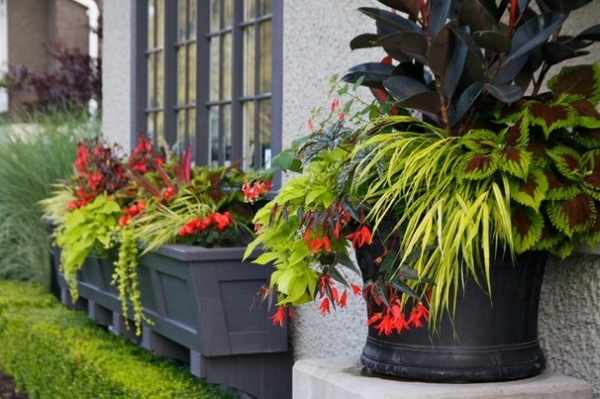
Japanese forest grass (Hakonechloa macra ‘Aureola’, zones 4 to 9) has gracefully arching chartreuse blades that resemble bamboo and is a natural choice for a spiller in your container arrangement.
Japanese forest grass is deciduous and prefers partial shade to partial sun. Allow the blades to turn to a straw color in fall and winter for multiseason interest. Trim them back in late winter before the new blades emerge in spring.
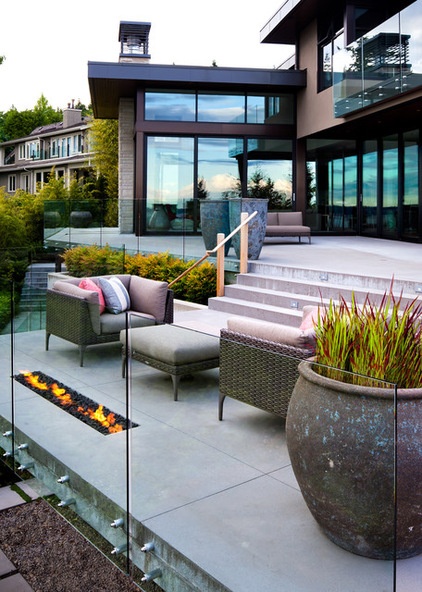
The One-Plant Containers
If you’re looking for a more minimalist or contemporary look that still has the wow factor, try Japanese blood grass (Imperata cylindrica ‘Rubra’, zones 5 to 9). Plant a mass of Japanese blood grass in a single container or cluster of containers for a dramatic burst of vertical blades that transition from bright green at the base to fiery (or blood) red at the tips.
Japanese blood grass is a deciduous grass that prefers moist, well-drained soil in full sun to partial shade.
The straight species of Imperata cylindrica is on the Federal Noxious Weeds list, most commonly invading tropical and subtropical regions. ‘Rubra’, or ‘Red Baron’, is listed as noninvasive, but it’s still best to be aware of where it’s planted. Pots are a good option, since they keep it fully contained.
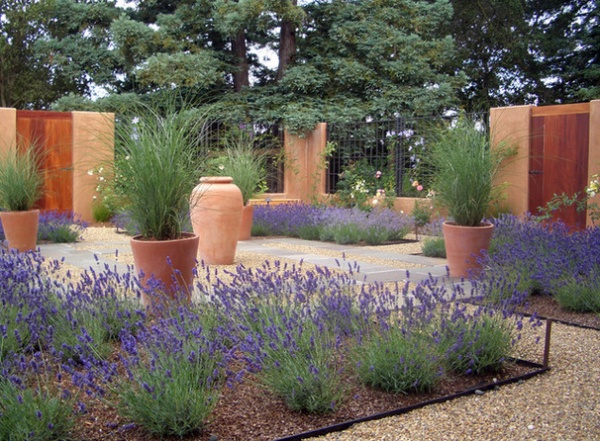
Due to its size, maiden grass (Miscanthus sinensis, zones 5 to 9) is another grass that makes a dramatic statement as a single specimen. Maiden grass is a perennial that sends up reddish-pink plumes of flowers during the summer that mature to tan in the fall. It can grow up to 8 feet tall.
Cultivars such as Miscanthus sinensis ‘Morning Light’ stay somewhat small, at 4 feet tall and wide. Its white-edged blades give off a silvery glow when the sun catches them.
Tell us: What are some of your favorite grasses for container gardens?
More:
The Secret Formula for Grouping Plants in a Pot
10 Ways to Take Containers Beyond the Patio
Related Articles Recommended












